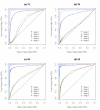CARAT: a novel method for allelic detection of DNA copy number changes using high density oligonucleotide arrays
- PMID: 16504045
- PMCID: PMC1402331
- DOI: 10.1186/1471-2105-7-83
CARAT: a novel method for allelic detection of DNA copy number changes using high density oligonucleotide arrays
Abstract
Background: DNA copy number alterations are one of the main characteristics of the cancer cell karyotype and can contribute to the complex phenotype of these cells. These alterations can lead to gains in cellular oncogenes as well as losses in tumor suppressor genes and can span small intervals as well as involve entire chromosomes. The ability to accurately detect these changes is central to understanding how they impact the biology of the cell.
Results: We describe a novel algorithm called CARAT (Copy Number Analysis with Regression And Tree) that uses probe intensity information to infer copy number in an allele-specific manner from high density DNA oligonuceotide arrays designed to genotype over 100,000 SNPs. Total and allele-specific copy number estimations using CARAT are independently evaluated for a subset of SNPs using quantitative PCR and allelic TaqMan reactions with several human breast cancer cell lines. The sensitivity and specificity of the algorithm are characterized using DNA samples containing differing numbers of X chromosomes as well as a test set of normal individuals. Results from the algorithm show a high degree of agreement with results from independent verification methods.
Conclusion: Overall, CARAT automatically detects regions with copy number variations and assigns a significance score to each alteration as well as generating allele-specific output. When coupled with SNP genotype calls from the same array, CARAT provides additional detail into the structure of genome wide alterations that can contribute to allelic imbalance.
Figures







Similar articles
-
Allelic dosage analysis with genotyping microarrays.Biochem Biophys Res Commun. 2005 Aug 12;333(4):1309-14. doi: 10.1016/j.bbrc.2005.06.040. Biochem Biophys Res Commun. 2005. PMID: 15982637
-
Major copy proportion analysis of tumor samples using SNP arrays.BMC Bioinformatics. 2008 Apr 21;9:204. doi: 10.1186/1471-2105-9-204. BMC Bioinformatics. 2008. PMID: 18426588 Free PMC article.
-
A Hidden Markov Model to estimate population mixture and allelic copy-numbers in cancers using Affymetrix SNP arrays.BMC Bioinformatics. 2007 Nov 9;8:434. doi: 10.1186/1471-2105-8-434. BMC Bioinformatics. 2007. PMID: 17996079 Free PMC article.
-
Comparing CNV detection methods for SNP arrays.Brief Funct Genomic Proteomic. 2009 Sep;8(5):353-66. doi: 10.1093/bfgp/elp017. Epub 2009 Sep 8. Brief Funct Genomic Proteomic. 2009. PMID: 19737800 Review.
-
CNV discovery using SNP genotyping arrays.Cytogenet Genome Res. 2008;123(1-4):307-12. doi: 10.1159/000184722. Epub 2009 Mar 11. Cytogenet Genome Res. 2008. PMID: 19287169 Review.
Cited by
-
The application of single nucleotide polymorphism microarrays in cancer research.Curr Genomics. 2007 Jun;8(4):219-28. doi: 10.2174/138920207781386924. Curr Genomics. 2007. PMID: 18645599 Free PMC article.
-
SNP arrays in heterogeneous tissue: highly accurate collection of both germline and somatic genetic information from unpaired single tumor samples.Am J Hum Genet. 2008 Apr;82(4):903-15. doi: 10.1016/j.ajhg.2008.01.012. Epub 2008 Mar 20. Am J Hum Genet. 2008. PMID: 18355774 Free PMC article.
-
Penalized weighted low-rank approximation for robust recovery of recurrent copy number variations.BMC Bioinformatics. 2015 Dec 10;16:407. doi: 10.1186/s12859-015-0835-2. BMC Bioinformatics. 2015. PMID: 26652207 Free PMC article.
-
Quantification of normal cell fraction and copy number neutral LOH in clinical lung cancer samples using SNP array data.PLoS One. 2009 Jun 26;4(6):e6057. doi: 10.1371/journal.pone.0006057. PLoS One. 2009. PMID: 19557126 Free PMC article.
-
Model-integrated estimation of normal tissue contamination for cancer SNP allelic copy number data.Cancer Inform. 2011;10:159-73. doi: 10.4137/CIN.S6873. Epub 2011 May 25. Cancer Inform. 2011. PMID: 21695067 Free PMC article.
References
-
- Sebat J, Lakshmi B, Troge J, Alexander J, Young J, Lundin P, Maner S, Massa H, Walker M, Chi M, Navin N, Lucito R, Healy J, Hicks J, Ye K, Reiner A, Gilliam TC, Trask B, Patterson N, Zetterberg A, Wigler M. Large-scale copy number polymorphism in the human genome. Science. 2004;305:525–528. doi: 10.1126/science.1098918. - DOI - PubMed
MeSH terms
Substances
LinkOut - more resources
Full Text Sources
Other Literature Sources

